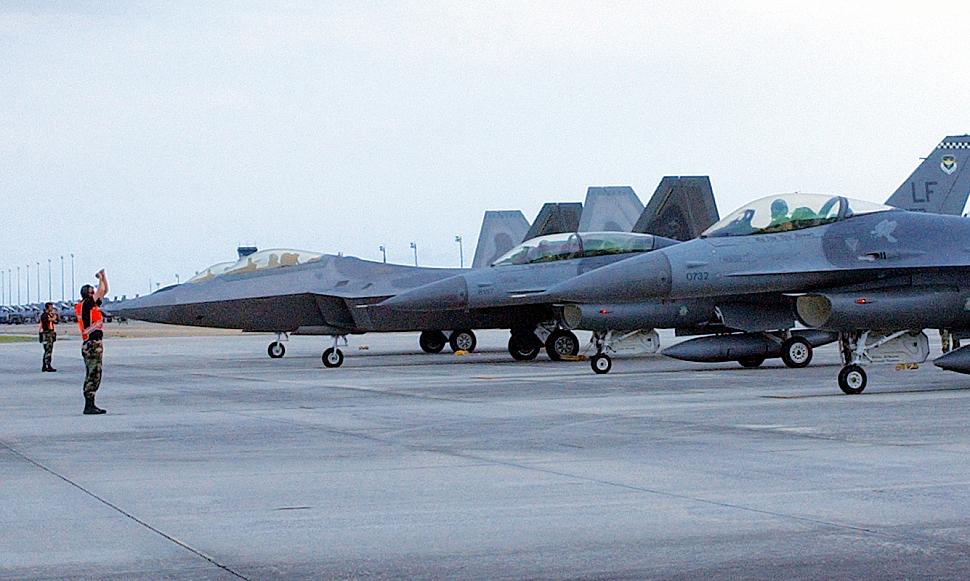Fighter Jet News
F-22 Raptor News
F-16s Battle F/A-22s
April 15, 2005 (by
Master Sgt. Mary McHale) -
Since firsts are meant to be memorable, it's a good bet the pilots with the 308th Fighter Squadron from Luke AFB, Ariz., won't soon forget their two-week visit at Tyndall AFB. The desert-based F-16 squadron arrived April 2 for dissimilar air combat training against F/A-22 pilots assigned to the 43rd Fighter Squadron at Tyndall.

"It's a treat to fly against the F/A-22 to see what it can do, and so far it's impressive," said Lt. Col. David Ellis, 308th FS commander. "We're getting some great training and great maintenance support here."
Tyndall conducts several dissimilar air combat training sessions each year, where fighter aircraft face off in mock air battles against the F/A-22 Raptor and F-15 Eagle.
Maj. Max Marosko, 43rd FS assistant director of operations, said the training is a win-win situation for both units.
"We can use (dissimilar air combat training) to increase our training capacity because it allows more training out of the same number of lines," he said.
For example, if just four Raptors fly against each other, they can do a single two-versus-two scenario. With DACT, the four Raptors can split and do twice the two-versus-two scenarios against the F-16s.
The major also said flying Raptor-versus-Raptor doesn't really allow for pilots to exploit effects of stealth and supercruise, two of the Raptor's premier characteristics.
"It's always better flying against different aircraft," Major Marosko said. "We get to capitalize on the strengths of our aircraft and see how other aircraft perform against us. They also get to see what the F/A-22 can do."
Major Marosko said stealth is only one of the many tools the Raptor brings to the fight and helps its pilots actually increase their sense of situational awareness. He said they also rely on its state-of-the-art integrated avionics.
"The jet does so much automatically; it really relieves the workload for the pilots so they can focus more on the big picture," Major Marosko said.
"With data link technology, I know everything my wingman knows so we don't have to communicate as much. That reduces mistakes," the major said. "In (other) aircraft, you're trying to communicate and receive information and keep up with everything going on in the cockpit. Now we enjoy a higher degree of success with a lot less work."
The major said the jet does alleviate the number of tasks the pilot must perform, but there's still the need to effectively conduct training.
"While the aircraft and avionics make up for so much, we still need to force learning points," he said. "The avionics are so advanced that they can offset pilot mistakes if the mission isn't challenging enough."
For that reason, Major Marosko said the Raptors will often be outnumbered during DACT, which helps reinforce training goals.
"We usually have really good numbers, but there are times we make mistakes. That's all part of the training," he said.

Two F/A-22 Raptors and two F-16 Fighting Falcons from Luke AFB, Ariz., prepare to taxi as the crew chief signals brakes. The Falcons arrived here April 2 to conduct dissimilar air combat training against the Raptors. [U.S. Air Force photo]
Tyndall conducts several dissimilar air combat training sessions each year, where fighter aircraft face off in mock air battles against the F/A-22 Raptor and F-15 Eagle.
Maj. Max Marosko, 43rd FS assistant director of operations, said the training is a win-win situation for both units.
"We can use (dissimilar air combat training) to increase our training capacity because it allows more training out of the same number of lines," he said.
For example, if just four Raptors fly against each other, they can do a single two-versus-two scenario. With DACT, the four Raptors can split and do twice the two-versus-two scenarios against the F-16s.
The major also said flying Raptor-versus-Raptor doesn't really allow for pilots to exploit effects of stealth and supercruise, two of the Raptor's premier characteristics.
"It's always better flying against different aircraft," Major Marosko said. "We get to capitalize on the strengths of our aircraft and see how other aircraft perform against us. They also get to see what the F/A-22 can do."
Major Marosko said stealth is only one of the many tools the Raptor brings to the fight and helps its pilots actually increase their sense of situational awareness. He said they also rely on its state-of-the-art integrated avionics.
"The jet does so much automatically; it really relieves the workload for the pilots so they can focus more on the big picture," Major Marosko said.
"With data link technology, I know everything my wingman knows so we don't have to communicate as much. That reduces mistakes," the major said. "In (other) aircraft, you're trying to communicate and receive information and keep up with everything going on in the cockpit. Now we enjoy a higher degree of success with a lot less work."
The major said the jet does alleviate the number of tasks the pilot must perform, but there's still the need to effectively conduct training.
"While the aircraft and avionics make up for so much, we still need to force learning points," he said. "The avionics are so advanced that they can offset pilot mistakes if the mission isn't challenging enough."
For that reason, Major Marosko said the Raptors will often be outnumbered during DACT, which helps reinforce training goals.
"We usually have really good numbers, but there are times we make mistakes. That's all part of the training," he said.
Courtesy of 325th Fighter Wing Public Affairs
Related articles:
Forum discussion:
Tags
- F/A-22 on track to go operational ( 2005-02-02)
- Crash leads to investigation, Raptor safety stand down ( 2004-12-22)
- The F-22 Raptor continues to meet and exceed all key performance parameters ( 2002-07-22)
- F-22 Raptor news archive
Forum discussion:
- Start a discussion about this article in the F-22 forum.
Tags
